






Throughout this month, Washington Informer contributor Curtis Knowles—you may know him as the creator of stellar news segments on WIN-TV—went around the District to ask more than 20 people what they do to protect the environment. The answers he received included an incredible list of ideas, and I want to share a few that resonated with me:
n In Print – feel the ink between your fingers of our Award Winning Print Edition
n On the Web – www.washingtoninformer.com updated throughout the day, every day

n On your tablet
n On your smartphone
n Facebook
n Twitter
n Weekly Email Blast – sign up at www.washingtoninformer.com
202-561-4100
THE WASHINGTON INFORMER NEWSPAPER (ISSN#0741-9414) is published weekly on each Thursday. Periodicals postage paid at Washington, D.C. and additional mailing offices. News and advertising deadline is Monday prior to publication. Announcements must be received two weeks prior to event. Copyright 2016 by The Washington Informer. All rights reserved. POSTMASTER: Send change of addresses to The Washington Informer, 3117 Martin Luther King, Jr. Ave., S.E. Washington, D.C. 20032. No part of this publication may be reproduced without written permission from the publisher. The Informer Newspaper cannot guarantee the return of photographs. Subscription rates are $55 per year, two years $70. Papers will be received not more than a week after publication. Make checks payable to:
THE WASHINGTON INFORMER

3117 Martin Luther King, Jr. Ave., S.E Washington, D.C. 20032 Phone: 202 561-4100 Fax: 202 574-3785 news@washingtoninformer.com www.washingtoninformer.com
In Memoriam Dr. Calvin W. Rolark, Sr. Wilhelmina J. Rolark

PUBLISHER
Denise Rolark Barnes
STAFF
Micha Green, Managing Editor Ron Burke, Advertising/Marketing Director
Shevry Lassiter, Photo Editor
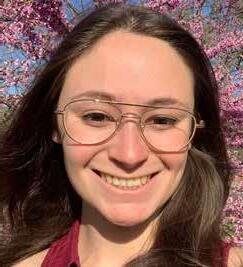

Lafayette Barnes, IV, Editor, WI Bridge DC
Jamila Bey, Digital Content Editor
Austin Cooper, Our House Editor Desmond Barnes, Social Media Stategist ZebraDesigns.net, Design & Layout
Mable Neville, Bookkeeper
Angie Johnson, Office Mgr./Circulation
REPORTERS
Kayla Benjamin, (Environmental Justice Reporter) Stacy Brown (Senior Writer), Sam P.K. Collins, Curtis Knowles, Brenda Siler, Lindiwe Vilakazi, Sarafina Wright, James Wright

PHOTOGRAPHERS
Shevry Lassiter, Photo Editor, Roy Lewis, Jr., Robert R. Roberts, Anthony Tilghman, Abdula Konte, Ja'Mon Jackson
• Use a reusable water bottle & get a faucet water filter so you can fill it with tap water
• Whenever possible, take public transit, walk or carpool rather than drive alone
• Participate in community cleanups and tree plantings
• Turn off lights when you’re not in the room, and use LED lights
• Get rooftop solar panels

• Enjoy & appreciate nature, and teach the youth to do the same
What inspired me about the responses Curtis received was their range: from the easy-peasy stuff, like turning lights off, to the big deal investments, like adding solar panels to the roof. Every piece of it matters. We all have to do what we can to protect our communities and our planet.
And the planet needs a lot of protecting. Climate change is very real, and it’s already changing our world; our children’s world will feel drastically different from our own, especially if we don’t stop burning fossil fuels within the next few years. The plastic and other waste that we throw away never truly disappears. Infuriatingly, the worst impacts of these problems on our health and livelihoods will not fall on the worst polluters. They will fall, instead, on the same communities that have nearly always faced the heaviest burdens.
When I think about protecting our world, the threats it faces can sometimes feel heartbreaking and overwhelming. Yet, since I joined the Informer in June, I’ve found inspiration and deep, deep joy in connecting with dozens upon dozens of people doing work in the environmental space. Some are educators, scientists, artists, activists. Many are parents.
Recently, I spoke with some folks from a community group in Southeast. They’re fighting for a tiny green space in their neighborhood. It’s the place where their children play and have played for decades, and these neighbors hold close to it. Talking to them showed me why this year’s theme—which the Informer is celebrating alongside groups around the globe—is “Invest in Our Earth” rather than “Protect Our Earth.”
We want protection for our communities, our families, our children. But protection is only the beginning of what we want for them. We want investments so that they can thrive. We want them to be cherished and held close. To be loved.
Protecting our planet is protecting our communities, families and children. And loving our Earth is loving them, too.
In this sustainability supplement, I hope you can find inspiration in even more ways that people, organizations and communities invest in our Earth. Some of my favorites include D.C.’s school gardens program, which Sam P.K. Collins writes about on page 20, and the amazing history of the first Earth Day, which James Wright discusses on page 22.
And if you or someone you know has something to share about what investing in our earth means to you—please reach out! You can find me on Twitter at @KR_Benjamin or at kaylarbenjamin@washingtoninformer.com.
Cheers,
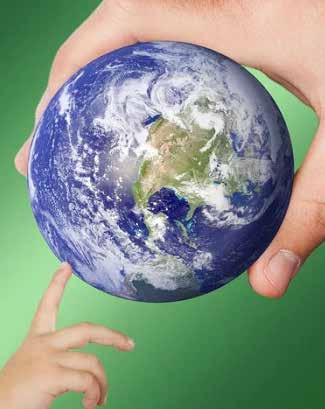
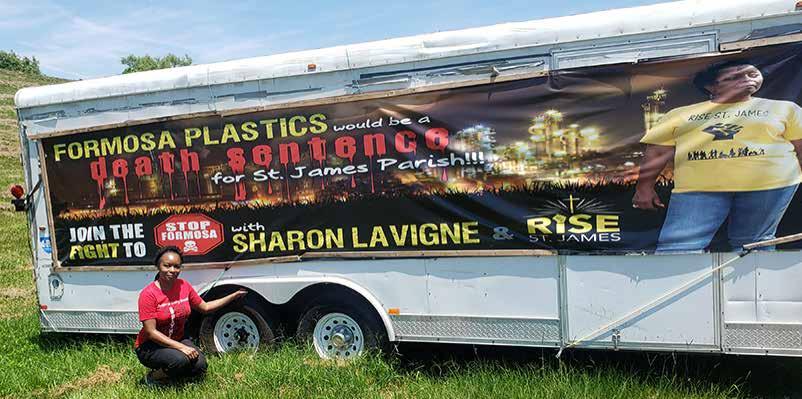
In the last year, the U.S. secured historic clean energy plan investments from the Infrastructure Investment and Jobs Act (IIJA), Inflation Reduction Act (IRA), and CHIPS and Science Act. This funding – nearly $550 billion for climate investments – can position our country to drive transformational progress on pollution, energy security and jobs in clean energy and manufacturing. Getting those laws through Congress to President Biden’s desk was no easy feat — they have been decades in the making — and this next chapter may be just as challenging: implementing those clean energy investments swiftly and fairly across the nation.
We have an unprecedented opportunity to redesign our energy system. These historic government investments give us the tools we need to replace our dirty and unsustainable fossil fuel economy with a clean energy future that will reduce harmful pollution, improve our health, make us more energy secure and heal the planet. But that does not stop fuel companies and their allies from trying to undermine the progress made to protect record-breaking profits at our expense.
Our health depends on a healthy planet. The clean energy plan invests in air monitoring, cleaner ports and community-led initiatives to confront the worst harms of air pollution and improve health.
EPA (Environmental Protection Agency) estimates there are nine million lead pipes currently delivering drinking water into homes and businesses across the United States—putting millions at risk for devastating harms, including permanent neurological damage and coronary heart disease. Replacing these pipes is an essential public health need.
By 2026, more than $15 billion (about $46 per person in the US) will flow to states and local water utilities—bringing both safer drinking water to millions of Americans and jobs for workers in affected communities. This is a result of funding for lead pipe
replacements is available through the IIJA, which President Biden signed into law in November 2021.
In addition to air monitoring, cleaner ports and community-led solutions, a suite of strong executive actions for common pollutants like soot, vehicle tailpipe emissions, and industrial resources will help us close the gap on the cumulative impact of climate change on Black and Latin communities, the communities most harmed by our continued reliance on fossil fuels.
Developing and producing clean energy and transportation in the U.S. is creating family-sustaining jobs in big cities and small towns—jobs for geologists, engineers, scientists, construction workers and more. These new clean energy and infrastructure jobs are American jobs that solve American challenges.
Meanwhile, jobs in oil, gas and coal have not recovered to their pre-pandemic levels. Fossil fuel companies have spent decades creating barriers to entry for renewables: tax policy that favors dirty energy, special rules for oil, gas, and coal, and sweetheart deals that protect them from real financial
competition with clean energy. Our communities do not have to be “sacrifice zones,” we can limit this pollution through the legal and regulatory process.
The industrial and manufacturing sector itself is also responsible for a quarter of U.S. emissions. This includes investments for clean energy technology manufacturing that will help maximize jobs building electric vehicles, solar, wind and more, while minimizing supply chain disruptions and driving down pollution from the industrial sector that disproportionately impacts Black and Latin Americans.
The clean energy plan gives us the opportunity to build out the infrastructure of the future while also installing guardrails to protect the places and communities most impacted by this development.
Black, Hispanic and Indigenous communities and low-income areas face an enormous and unjust burden of pollution because fossil fuel industries are more likely to be located near them. They also face the greatest hazards from climate change while contributing the least, and they have the fewest resources to recover from its harm.
We must ensure that federal and state governments implement the clean energy plan’s investments in an equitable and just way while opposing any effort that adds pollution to overburdened communities.
We can and must heal our world for all of us and for future generations. Every action our leaders take should move us toward abundant clean energy. By developing innovative technologies, modernizing our electrical grid, making ourselves less dependent on the global market for fossil fuels and driving down the cost of clean sources of energy, everyone will benefit. WI
We are Environmental Defense Fund, the organization that is all-in on climate — the greatest challenge of our time. Our game-changing solutions put people at the center of all we do to support public health, stabilize the climate and strengthen people and nature’s ability to thrive. We work where we can make the biggest impact. Bringing you in-depth analyses and resources that feature the people and ideas making a difference to advance clean energy and clean beauty justice.


When you think about harmful chemicals, you might imagine a hazardous waste site or water contamination. Toxic chemicals also lurk in the food we eat and products we use every day.
Who knew that ingredients in beauty and personal care products could impact your health? The issue of toxic chemicals in these products is an equity issue. Beauty and personal care products marketed to women of color often contain more toxic chemicals than those marketed to white women.
• Ingredients in some hair care products commonly used by Black women, such as hair lotion, leave-in conditioners, root stimulators and hair oil, have been found to contain
ingredients that disrupt hormonal activity.
• There is a 40% greater risk of early onset periods — an indicator for heightened breast cancer risk — for women who used hair oil or hair perm treatments as children.
• In one study, Dominican women who used skin lightening creams had up to 30 times higher levels of mercury in their bodies.
• The levels of diethyl phthalate, a common fragrance ingredient, and methyl paraben, a preservative, are 80% and 100% higher in African Americans than white Americans, respectively.
The color of your skin or the texture of your hair should not put you at greater risk of exposure to toxic chemicals.
This toxic beauty inequity has flown under the radar for far too

long, which is why educators, community advocates and clean beauty influencers are speaking out.
Public health researchers are expanding the body of knowledge around the links between certain toxic chemical exposures and disease, as well as the root causes of exposure.
For instance, research by environmental health experts show that one’s exposure to toxic chemicals through personal care products can be driven by where you live, where you work and cultural norms. Factors like these can impact the long-term well-being of individuals and entire communities.
Organizations like the Resilient Sisterhood Project are helping Black women understand reproductive diseases that disproportionately affect them, the links to chemical exposures and opportunities for action. And beauty influencers are leveraging their platforms to build awareness among beauty enthusiasts.
But to achieve clean beauty justice, we need policymakers and companies
to respond to this pressure and drive real change in the beauty industry.
In late 2022, Congress passed the Modernization of Cosmetics Regulation Act, the first major update to the Food, Drug and Cosmetics Act in 84 years. While the passage of the bill breaks the historical impasse on the regulations of the industry, more work is needed to put policies in place that further protect communities of color. While efforts on beauty justice cosmetic legislation continue, some companies like Credo, Sephora and Target have committed to sell beauty products without harmful ingredients and with lower environmental footprints — what publicly has been referred to as “clean beauty.”
These efforts are a step in the right direction when it comes to cleaning up the beauty aisle. We also need to ensure more clean
beauty options are available for women of color.
Putting an end to this toxic reality requires getting brands and retailers to put racial equity front and center in their clean beauty efforts.
And they need to ensure that clean beauty products are available, accessible and affordable for every single customer.
Companies can do this by ensuring their chemicals policies include a specific, time-bound commitment to address equity, while also working to increase supply chain transparency, disclose product information to consumers, and prioritize chemical safety in designing products marketed to people of color.
Beauty should not cost us our health. We need clean beauty justice. Take a stand with us at cleanbeautyjustice.org. WI
#CLEANBEAUTYJUSTICE
#CLEANBEAUTYJUSTICE
#CLEANBEAUTYJUSTICE
#CLEANBEAUTYJUSTICE
#CLEANBEAUTYJUSTICE
#CLEANBEAUTYJUSTICE #CLEANBEAUTYJUSTICE
#CLEANBEAUTYJUSTICE #CLEANBEAUTYJUSTICE
#CLEANBEAUTYJUSTICE
#CLEANBEAUTYJUSTICE
#CLEANBEAUTYJUSTICE
#CLEANBEAUTYJUSTICE
#CLEANBEAUTYJUSTICE
#CLEANBEAUTYJUSTICE
#CLEANBEAUTYJUSTICE
#CLEANBEAUTYJUSTICE
#CLEANBEAUTYJUSTICE
#CLEANBEAUTYJUSTICE
#CLEANBEAUTYJUSTICE
#CLEANBEAUTYJUSTICE #CLEANBEAUTYJUSTICE
TOXIC A TAKE STAND AGAINST BEAUTY’S EQUITY PROBLEM AT CLEANBEAUTYJUSTICE.ORG





Did you know that approximately 1.3 billion tons of food are wasted each year globally? Discarded food is dumped into landfills, releasing greenhouse gas as it slowly rots away.
According to the U.S. Environmental Protection Agency, food is the largest category of material placed in municipal landfills in the United States. Food waste emits methane, a powerful greenhouse gas contributing to climate change. Instead of nourishing us, our landfilled food contributes to air and water pollution.
In Prince George’s County, almost 34% of what is being disposed of at the County’s landfill is compostable, with food and food-soiled products making up the largest portion of the materials. That’s one-third of our landfill filled with valuable materials left to pollute our environment.
Prince George’s County is a na-
tional leader in being green. And now, with our curbside composting program, we are setting the standard for environmentally smart and friendly waste management. Our Organics Composting Facility is the most advanced on the East Coast. Located in Upper Marlboro, we process nearly 65,000 tons of material annually. That’s a lot of materials being saved, and it’s not even the best part:
• Yard trim and food scraps are organically processed into Leafgro GOLD®, a nutrient-rich, dark, soillike material that makes us greener by promoting plant growth.
• The sale of Leafgro GOLD® to professional landscapers helps cover the cost of facility operations, meaning the jobs generated by the facility and the additional weekly waste removal service that comes with curbside composting are at no extra cost to taxpayers.
Submitted by Prince George’s County Department of the Environment
When we think of “composting,” we often think of backyard tubs of raked leaves and potato peels. Backyard compost is great for the environment and your garden, but it’s labor-intensive. We might not have the time, space, or desire to undertake the process.
Curbside composting isn’t in your backyard. It’s equivalent to your regular recycling or trash collection. You toss the materials in your cart, and your municipality handles the rest. It’s an extra step, but it’s the next step for our environment. We went from throwing soda cans in the garbage to recycling them. Now, we will do the same for food waste and yard trim.
Prince George’s County is leading the charge with PGC Composts, a curbside composting program for residents using County waste removal services. PGC Composts has been rolling out in
phases around the County, and we have some tips for those new to the program.
What are my starter kit materials for?
Our Resource Recovery Division will drop off an exterior 32-gallon wheeled green cart, much like the one you use for recycling and trash. Inside this cart, you’ll find a two-gallon kitchen pail and educational materials to help guide you. Find a convenient spot for your kitchen pail. Many residents place it next to their sink, or wherever they prep their food, so they can easily drop peels and shells into the pail. Then, empty your pail into your wheeled green cart. Do not put your kitchen pail in the cart! Curbside compost is collected starting at 6 a.m. every Monday.
• Our state-of-the-art facility uses the “Gore Cover Bunker” method to create ideal composting conditions while efficiently eliminating odors and emissions. Compost is finished in 30 days, with no footprint for facility neighbors.
• While backyard composting is an excellent source reduction effort and provides valuable compost, our facility accepts and can break down animal products like meat, bones, cheese, and seafood shells without the strong odors or otherwise nuisance wildlife.
Without a doubt, our curbside composting program is great for our economy and environment.
How can you get involved? You may already have your supplies! You may receive a wheeled green compost cart if you’re a resident with County waste residential curbside collection services. You will find a kitchen pail and a “welcome packet” in the new cart—your comprehensive service guide. You can also find the welcome packet at http://mypgc.us/compost. Our handy guide will explain the how, why, and what of composting and provide some handy tips.
You might not have your supplies yet. Our Resource Recovery team is working on completing the program expansion by the end of this calendar year. All eligible residents in the County waste residential curbside collection service will receive a cart.
How do I handle odors in my kitchen pail and wheeled green cart?
There isn’t much difference between throwing your scraps in the trash and your kitchen pail, but residents who expressed concern found these tips helpful:
• Store meat scraps, bones, and fishy items in the freezer until collection day to prevent odors in your pail and green cart.
• Layer yard trim or uncoated paper products in the bottom of your green cart to keep it clean and dry.
• Hand wash or machine wash your kitchen pail after use. (It’s dishwasher safe!)
• Sprinkle baking soda in your cart or pail to control odors.
Can I use bags, like I do in my kitchen trash?
You can line your kitchen pail with approved compostable bags available at stores. They must be labeled as either “home com-
CONTINUED ON PAGE S-7
pail in a convenient place; many residents recommend placing it by the sink. If you wish to, you can use a compostable bag liner for easy cleanup, but the kitchen pail is also dishwasher safe. Then, fill it up with food scraps and food-soiled paper items. Just like your kitchen trash or recycling can, empty the pail into your wheeled green cart when it’s full. Yard trim may also be included within the wheeled green cart. Mixing some leaves or grass with your food scraps inside the compost cart will help absorb potential moisture from the food scraps. Pizza boxes, paper towels, napkins, and paper plates absorb food moisture and should be included in the compost service program. Roll your cart to the curb by 6 a.m. on Monday, and we will take care of the rest!
Participating in curbside composting is a small change in habit that makes a big difference. Putting food scraps in your kitchen pail instead of your trash helps our air and water, and creates an all-organic rich nutrient soil amendment. If every Prince Georgian committed to doing this, we would significantly reduce our landfilled waste together. If you love Prince George’s County as I do, you’ll make this change and encourage your community to do the same. Together, we can keep our County green and beautiful!
Once you have your supplies, the rest is easy. Just keep your kitchen
Thank you, Prince George’s County Department of the Environment Director Andrea Crooms

The Washington Informer’s 2023 Sustainability Supplement is brought to you in part by PGC Composts. Prince George’s County is a leader in environmental stewardship, and now, our curbside composting program will continue to propel us to a zero-waste future.
PGC Composts is for residents who use County-collected trash and recycling pickup. By the end of 2023, every household will receive materials to begin composting (one wheeled green cart and kitchen pail). These containers will include educational materials to help residents prepare compost materials for pickup on Mondays only.
Collected food scraps and yard trim will be sent to our state-ofthe-art facility and processed into Leafgro GOLD®, a nutrient-rich, dark, soil-like material that makes us greener by promoting plant growth. The sale of Leafgro GOLD® to professional landscapers helps cover the cost of facility operations, making PGC Composts environmentally and financially beneficial for our County.
With PGC Composts, Prince Georgians can make a big impact on our environment with just a small change in daily habits. Follow us on social media for updates at @PGCSprout or visit us at mypgc.us/ compost.
1.
Put your kitchen pail in a convenient location, like on your countertop, so you can easily collect food scraps and leftovers.
2.
When the pail is full, empty contents into the green cart. All food scraps must be contained in the green cart. Remember to bring your pail back inside.
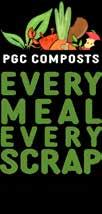
3.
Place your green cart curbside by 6 a.m. on Monday. To prevent odors, layer yard trim or uncoated paper products in the bottom of your green cart.
Did you know each person in the U.S. throws away an average of 1,200 pounds of organic waste that could be composted every year?
Source: Indiana University Environmental Resilience Institute

CONTINUED FROM PAGE S-6
postable” or “commercially/industrially compostable.” Bags labeled biodegradable but not compostable aren’t accepted. Brown paper bags (like those from the grocery store) are fine. A full list of acceptable bags can be found on mypgc.us/compost.
• It’s not just vegetable peels and grass clippings!Fruits and vegetables—any kind, they don’t need to be organic!
• Dairy products (no liquids, just butter, cheese, etc.)
• Bread, pasta, grains (no raw dough)
• Seafood (including shellfish)
• Eggs and egg shells
• Paper towels and paper napkins used in your kitchen
• Coffee grounds and paper coffee filters
• Uncoated, non-waxy compostable paper plates
• Newspaper, including foodsoiled newspaper
• Tea bags and loose tea
• Meat, including bones
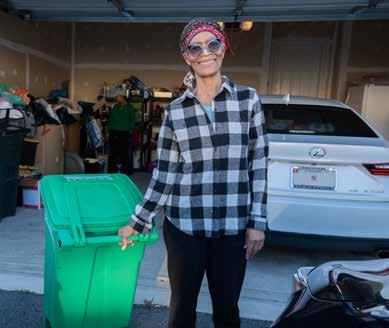
• Pizza boxes—clean or greasy
• Loose and bagged grass (paper bags only)
• Loose and bagged leaves (paper bags only)
• Garden plant clippings
• Green woody waste
• Tree limbs and brush (tree limbs must be tied in bundles and placed next to the wheeled green cart at the curb)
• Used or old straw and hay
The list of non-compostable items is just as important. Improper materials can contaminate or damage our facility.

• Leftover cooking grease, fats, and oil
• Facial or toilet tissue
• Diapers
• Pet waste, including cat litter
• Plastic bags, wrappers, chip bags, or film
• Styrofoam containers
• Plastic containers, jugs, and bottles
• Glass of any kind
• Aluminum or steel cans, utensils, and pans
• Aluminum foil and disposable aluminum pans
• Foil-backed or plastic-backed paper
• Household trash/litter
Residents with County-provided trash and recycling services are eligible for our Curbside Composting program. By the end of 2023, every household will receive materials to begin composting “Every Meal. Every Scrap. Every Monday.” For additional questions, contact PGC311 or visit mypgc.us/compost.
Follow us on social media for more curbside composting tips and updates at @PGCSprout! WI
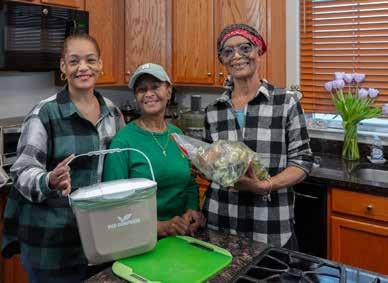

seafood andshellfish
peels
bread, grains, and pasta
loose tea and bags
meat bones eggs and eggshells
newspapers
fruits and vegetables
paper plates, napkins, and pizza boxes
coffee grounds and filters
tree limbs and brush
Did you know nearly 34% of the garbage landfilled in our County is food waste that could have been composted?
Help us create a greener community with our FREE curbside composting for eligible residents.
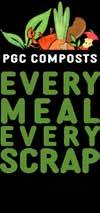
In the past few years, you’ve probably encountered many mentions of the benefits of replacing and refreshing aging pipeline systems. Our own Washington Gas articles here in the Washington Informer often discuss pipeline systems and our committed goals for safety and risk mitigation throughout our service areas.
We are vigorously pursuing a thoughtful, risk-based approach to pipeline replacements throughout the DMV. Through significant capital investments, we are enhancing the reliability of our infrastructure, which includes the modernization of our facilities and pipeline networks through repair and replacement.
Within our Utilities business, we invest in pipe replacement and related activities to improve the distribution network, mitigate potential risks and enhance safety. The goal is to upgrade our pipeline systems and place them on a longterm, sustainable path that will reliably serve our customers for years to come.
Washington Gas actively operates several large-scale accelerated pipe replacement programs throughout our business footprint. These long-term program initiatives have logged noteworthy results in recent years.
Beyond the enhanced safety and improving reliability of our pipeline network, as the data tables below illustrate, there is an ancillary benefit in that this work has the effect of lowering our emissions from aging infrastructure. In total from these efforts in Maryland, Virginia and Washington, D.C. as of the end of 2022, 352,270 metric tons of greenhouse gas equivalents have been reduced from our accelerated pipe replacement programs.*
GHGs equivalent reduction: 23,822 metric tons
Automobiles equivalent reduction: 5,098
Miles of pipe retired: 31.3

GHGs equivalent reduction: 105,199 metric tons
Automobiles equivalent reduction 22,513
Miles of pipe retired: 140.9
VIRGINIA’S ENERGY PROGRAM, OR SAVE

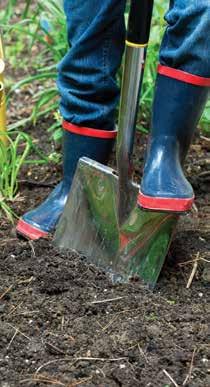


GHGs equivalent reduction: 223,249 metric tons
Automobiles equivalent
reduction: 47,775
Miles of pipe retired 174.2
Numerous studies across government agencies and private research firms underscore the practicality and high value of accelerated replacement pipe programs. For example, the Department of Transportation indicates that such a program “enhances safety and reliability, contributes to cost savings over the longer-term and is less disruptive to customers and communities than a reactive approach.” The American Chemical Society also states that “cities with successful pipeline replacement programs have 90% fewer leaks per mile than cities without such programs.”*

Washington Gas is committed to our continuing strategy of deploying accelerated pipeline replacement programs to replace risk-prone pipelines with newer pipes that enhances safety and improve reliability. As we celebrate our 175th anniversary in 2023, we are proud to pursue projects and programs that will enhance service to our many communities today while supporting the energy solutions of the future. WI
One of our most urgent goals is to help homeowners and disadvantaged communities throughout the District reduce their natural gas consumption. Washington Gas energy-conservation programs include rebates to lower the upfront cost of high-efficiency equipment; recommendations for small energy-saving actions; easy-to-install DIY measures; whole-home weatherization assistance; and large-scale, customized commercial retrofit projects.
These programs offer proven methods to lower energy costs while increasing reliability and comfort. If you or someone you know needs energy bill assistance, you have many options to receive help with your energy bill: installment and automated payment plans, budget planning and more.
Visit washingtongascares.com to learn more.

*Sources:
Washington Gas Accelerated Pipeline Programs: http://bit.ly/41i2kW3
AltaGas ESG Report 2022: https://bit.ly/41fX85a
Washington Business Journal: https://bit.ly/3GCzbwV
U.S. Department of Transportation: https://bit.ly/40cecZ2
American Chemical Society: https://bit.ly/3KvHbRK


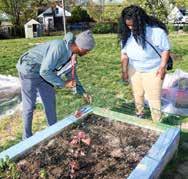 By Sam P.K. Collins WI Staff Writer
By Sam P.K. Collins WI Staff Writer
With longer days and warmer weather comes another opportunity for District public and public charter school students to get their hands dirty in school gardens across the city.
For more than a decade, they have been able to do so through the School Gardens Program coordinated by the Office of the State Superintendent of Education (OSSE) in conjunction with the Department of Parks and Recreation, D.C. Public Schools, Department of General Services, Department of Energy & Environment and the University of the District of Columbia (UDC).
Such collaboration has provided opportunities for young people, like those under urban agriculture teacher Coy McKinney’s tutelage, to connect with the earth, combat climate change and even pursue entrepreneurship through the production of smoothies, along with basil pesto and a special hot sauce made from cayenne peppers they’ve harvested.
Earlier this year, McKinney’s students at Friendship Public Charter School (PCS) - Technology Preparatory High School in Southeast kicked off the planting season by preparing 20 garden beds. Within a matter of months, they will harvest spinach, beets, lettuce, collard greens, basil, bok choy turnips, and raspberry bush among other crops.
The school grounds also has a greenhouse for year-round gardening, along with beehives and a chicken coop, all of which inspire conversation about food deserts and healthy eating. Another element of McKinney’s school gardening program revolves around the several pounds of food waste that he and 40 students have been able to convert into fertilizer.
“Caring for the environment is the baseline for everything,” said McKinney, who has taught urban agriculture at Friendship PCS - Technology Preparatory High School since 2014. “We try to make composting real by showing students that when sending food to a dump, you create methane. Through composting, we create natural fertilizer. Hundreds of pounds of food waste have been turned into worm casting. It’s ongoing. We’ve
mostly been using it for our plants.”
Friendship PCS - Technology Preparatory High School counts among several schools east of the Anacostia River that are affiliated with the School Gardens Program. Others include Garfield Elementary School, Thurgood Marshall Academy Public Charter School and Hendley Elementary School.
In March, students at Anacostia New Tech High School celebrated the development of a new greenhouse, living classroom and hydroponics facilities, the latter of which UDC brought to the school.

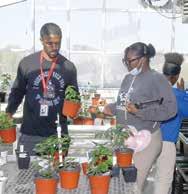
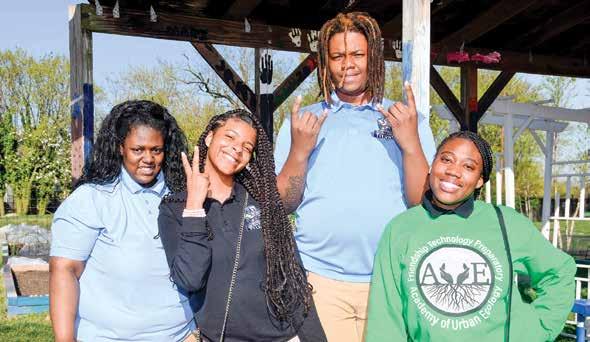
In total, 111 public and public charter schools, most of which are elementary level, coordinated on-campus gardening programs last school year, according to figures provided by OSSE. The education agency connects each participating school with various forms of support, including training done in partnership with the U.S. Botanic Garden, Friends of the National Arboretum and local nonprofit City Blossoms, along with numerous other organizations.
Sam Ullery, OSSE’s school gardening specialist, also provides technical assistance and connects schools to resources.
Ullery entered his role in 2011, shortly after the passage of the D.C.
Healthy Schools Act. That legislation not only created the School Gardens Program, but set health and nutrition requirements for District schools and agencies, promoted farm-to-school and sustainable agriculture practices, and launched an Environmental Literacy Program.
Reflecting on his experience, Ullery told The Informer that teachers have been able to use gardening to create more multidisciplinary, hands-on instruction of benefit to students. Later this spring, OSSE will coordinate a school garden bicycle tour, in partnership with Slow Food DC, BicycleSPACE and FoodCorps, during which young people can visit school gardens throughout Wards 7 and 8.
Students will also get another opportunity to showcase their horticultural skills when they enter a contest for the best school garden in the city, which Ullery described as a pivotal moment for many of the students who participate in the garden program.
“When students who struggle grasping information presented in the classroom are presented with the same information outside, sometimes they end up being the leaders [in the garden],” Ullery said. “They grasp that information quickly and see themselves as not only someone understanding and getting information, but teaching others that information. There’s a sense of pride in
school gardens. It’s something they create and you hear them bragging to their friends about.”
Last weekend, attorneys and staff members from Williams and Connolly LLP in Southwest joined students at Thurgood Marshall Academy Public Charter School in Southeast to prepare flower beds in the front school yard. This summer, members of the garden club will visit the Anacostia Watershed Society in Bladensburg, Maryland to explore career options in the field of horticulture.
Christina Schwarz has coordinated these activities, and more, for the garden club at Thurgood Marshall Academy PCS. With the planting season in full swing, she is working with four young people who put in hours of work on a dozen vegetable plant beds. Within a matter of weeks, they expect to start harvesting beans, squash, tomatoes, basil, parsley, green onions and chives. For four years, Schwarz has volunteered with the garden club, formerly called the green club. In her first year at the helm, she aspires to help students build comradery around gardening and use their craft to help the greater Anacostia community. Schwarz told The Informer that there have been talks about donating harvested crops to Thurgood Marshall Academy PCS’ food pantry.
At a time when faculty members, administrators, and parents alike have grown concerned about students’ socioemotional well-being, Schwarz said that the garden club has been the ideal outlet for young people in search of a viable after-school activity.
“I see them building relationships with each other in the garden, even if they’re not speaking,” said Schwarz, Thurgood Marshall PCS’ program manager. “There are times when time is up and we’re done, but students are telling me that they’re not done. There’s literally always work to be done so if we don’t stop we’d be there forever. It’s actually refreshing to see that they want to stay longer, and love being out here.” WI
@SamPKCollins

Along Valley Road, between 4th and Atlantic streets, a big, bright mural of butterflies hangs on a chain link fence, waiting to catch the eyes of drivers and pedestrians passing by. It’s one of many installations— all created by local artists—that surround the outside of The Well at Oxon Run, a 20,000-square-foot urban farm and community space that opened up for its second growing season last month.
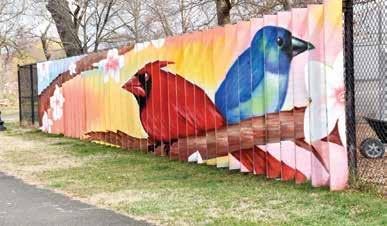
Beyond the gate, visitors can find rows of planter boxes, a greenhouse of fruit trees and patches of soil—the last of which already hosts green veggies like lettuce, kale, cabbage, turnips and collards. A small coop stands ready for a flock of chickens set to make a home there later this year.

The Well houses a little bit of everything for humans, too. An outdoor classroom and covered patio offer spaces to sit in the shade for conversation and learning. Regular classes and workshops held at the garden range from yoga to drumming to African American food and farming traditions (that last workshop, officially titled Seed & Culture Saturdays, will begin again on May 6, led by Falani Spivey of Byrd’s Nest Box—featured on page 20).
The Ward 8 Water Watchers, a program hosted by The Green Scheme with a home base at The Well, offers youth the outdoor education opportunities to learn from scientific experts about environmental justice issues impacting nearby waterways like Oxon Run Creek. Chill days designed for elders in the community show up on the schedule alongside bustling events like health and resource fairs.
The space’s next event you should know about? An Earth Day seed swap, celebration and book drive! Come visit the Informer and Washington Informer Charities at our table at The Well—300 Valley Ave SE—from 1pm to 4pm on April 22. WI

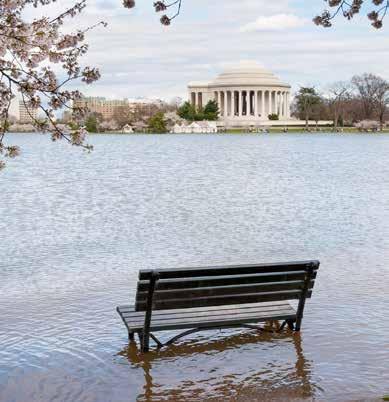 Emile C. Thompson Chairman, Public Service Commission of the District of Columbia
Emile C. Thompson Chairman, Public Service Commission of the District of Columbia
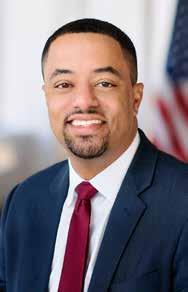
One word often comes to mind when I speak about the District of Columbia’s many accomplishments in the clean energy transition: proud.
I’m proud of the work that District leadership and agencies, including the Public Service Commission of the District of Columbia (DCPSC), have done to help the city reach its aggressive climate policy goals. I’m proud that the District leads the way in setting renewable energy standards. And I’m especially proud that the city is ensuring that our clean energy transition is equitable, affordable, and creates climate resiliency.
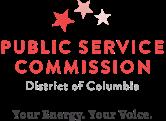
These important goals were the main topics at the recent 2023 District of Columbia Clean Energy Summit hosted by the DCPSC.

As the District, like the rest of the nation, struggles with the effects of climate change, including flooding, intense storms, and higher temperatures, it’s more important than ever that we identify and overcome the challenges to a clean energy future.
Acting Federal Energy Regulatory Commission Chairman and former DCPSC Chairman Willie L. Phillips opened the summit with a keynote address, charging us all with “committing to act urgently on equity and climate change,” a sentiment echoed by At-large D.C. Councilmember Kenyan R. McDuffie, who highlighted the Clean Energy DC Act, environmental justice, and the need to create opportunities for small minority-owned businesses in the District.
On a panel discussing the Inflation Reduction Act and Infrastructure Investment and Jobs Act, Joint Office of Energy and Transportation Policy Advisor Richard Ezike also touched on environmental justice, noting that it’s a “top priority” for his office. “Many communities of color, especially black and brown, have been negatively impacted by the way our states were planned, and many of those impacts still exist today,” he added.
The summit also tackled workforce and supply chain development issues related to clean energy. I think many people hear and know about the clean energy transition, but they don’t know how they can participate, how they’re a part of it, or how some of the big topics that are discussed really apply to them. One clear way is through employment — building equitable clean energy manufacturing and supply chains creates quality, in-demand jobs and programs. At the summit, American Council on Renewable Energy Senior Vice President for Diversity, Equity, Inclusion, and Justice Constance Thompson explained that “this is an awesome opportunity for wealth creation for people of color, by providing funding services for small businesses to create clean energy.”
Another key component of the clean energy transition that may not always get the same bandwidth as some other topics do is affordability. What will the transition cost? How will those costs be allocated among individuals and businesses? Regulatory Assistance Project Managing Principal Damali Harding raised similar concerns at the summit, stressing the need for equity in all clean energy policies. “If we don’t have equity in policies that are specific, definitive, and
measurable, that means we can’t go back and hold ourselves accountable for moving the affordability needle,” she remarked.
To many, affordable electricity has become a basic necessity. As the local utility regulator, the DCPSC has an important and integral role in meeting that need. The District’s renewable portfolio standard mandates that local utilities produce power with 100% renewable energy by 2032, with 10% of that electricity coming from solar sources by 2041.
I’m proud of the federal, state, local, and industry leaders who’ve put in the hard work to get us this far, and I hope they’ll stay the course and push for more aggressive renewable energy goals here in the District and across the county.
Watch a full recording of the 2023 District of Columbia Clean Energy Summit at https://dcpsc.org/ces

10:30 AM - 11:15 AM
Registration, Breakfast & Networking
11:15 AM - 11:40 AM
Opening Remarks and Keynote

11:45 AM - 12:15 PM
It's Getting Hot in Here: Climate Change 101


With media personality Nori-Nori leading our conversations, the DC Office of the People’s Counsel is excited to be hosting informative and exciting sessions, with speakers from youth advocates, to government agencies, to brands who are committed to climate action. Join us for a day of learning, action, networking, swag, and more!
Featuring speakers, panels, breakouts, and networking, this OPC Youth Climate Summit will educate and empower Gen Z and Millenials to bring climate action and advocacy into all areas of their life. Environmental stakeholders and DC residents of all ages are invited to attend this free event.
12:35 PM - 1:15 PM
Breakout Session 1 - My Brands, My Change

12:35 PM - 1:15 PM
Breakout Session 2 - Show Me the Green: Career, job, and Intern opportunities.
12:35 PM - 1:15 PM
Breakout Session 3 - Are We Ready for a Green Future?
Interpretation services for Spanish language and sign language (ASL) will be available onsite free of charge. If you require a reasonable accommodation or non-English language interpretation, contact the Office of the People’s Counsel at (202) 727-3071 or info@opc-dc.gov by April 24th.
1:40 PM - 2:20 PM
Be the Go-Go for Change in DC


2:25 PM - 3:30 PM
Lunch and Networking
SCAN HERE TO RESERVE YOUR SPOT





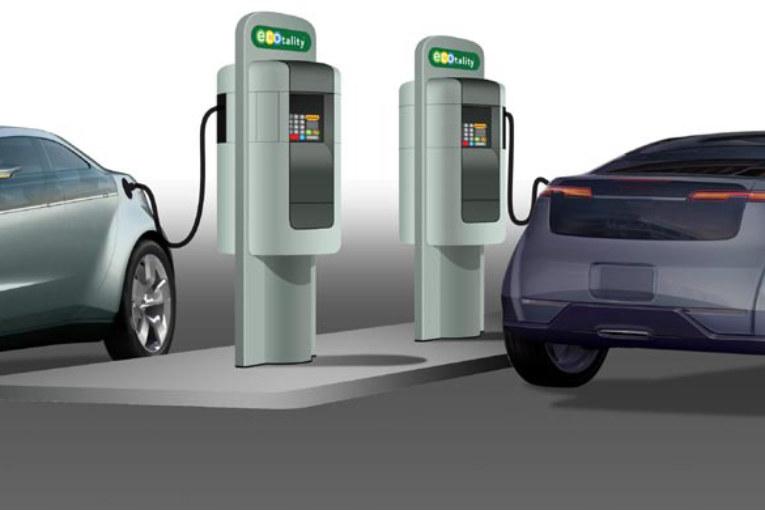
Here in the District, we define sustainability as advancing equity, environmental protection, and economic development at the same time. Our sustainability plan is called Sustainable DC 2.0, since it was updated in 2019 after the original Sustainable DC Plan was released in 2013. The plan includes goals, targets, and actions out to 2032 led by District government agencies and our partners to make the District of Columbia the healthiest, greenest, most livable city for all residents. With such a bold and broad vision, the plan covers a lot of ground; the topics included are governance, equity, built environment, climate, economy, education, energy, food, health, nature, transportation, waste, and water.

Sustainable DC 2.0 is a living, breathing document kept alive through convenings by the implementing agencies and partners to report out on progress, with agencies using it as a launchpad to create more detailed plans for specific areas of concern such as extreme heat, community members referencing it to advocate to policymakers, and policymakers drawing upon it to advance new initiatives. To date, 98% of the 167 actions in the plan are either underway or complete. But that doesn’t mean we’re ready to coast.
Given the magnitude of changes we’ve seen in the District and the world since Sustainable DC 2.0’s release in 2019, it’s time for a refresh. Sustainable DC 2.0 was developed through input from thousands of District residents, including one-on-one conversations, phone polls, focus groups, community meetings, and more. We want to carry that valuable input forward into Sustainable DC 3.0, while making targeted improvements to the plan to enhance equity and update quantitative targets.
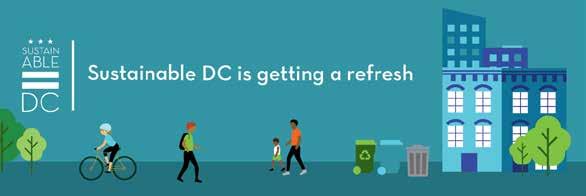
We want to ensure the plan’s ac-
tions are advancing equity, and we have many more tools at our disposal to do so than we did in 2019. The District has a suite of racial equity impact assessment resources that we will use, in combination with community engagement with frontline populations, to make sure the plan prioritizes racial equity, climate justice, and economic justice. As a separate but related exercise, we will work with the agencies and partners responsible for implementing the plan to make sure we have measurable targets and the data necessary to track them.


“A sustainable city is one where people feel like they have a future,” said DOEE Interim Director Richard Jackson. “Our Sustainable DC 2.0 Plan includes a lot of ambitious actions to make sure all of our residents feel like they can see themselves here long term. But every plan needs to keep up with the times and get a refresh every now and then. There is a lot in the plan that we want to keep and we still need to achieve. We just want to make sure it’s up to date with our priorities and maximizes opportunities to close inequity gaps.”
To stay up to date on the development of Sustainable DC 3.0, please visit https://publicinput. com/u3366. WI



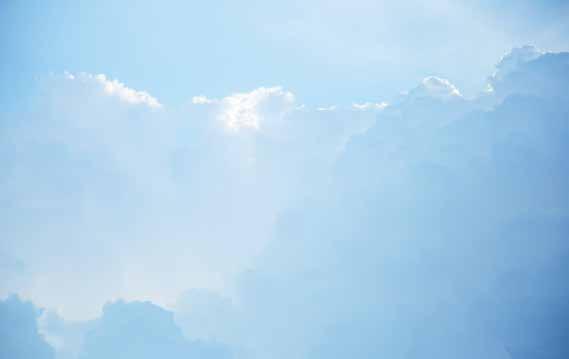
Paper or plastic?
Neither, thank you. It’s cloth for you because cloth bags are sustainable, recyclable, and reusable. Using cloth bags is just one more way for you to help save the planet, but there are so many more ways to be "green" – so why not take things to the next step by finding these great Earth Day books for the whole family?
Even the smallest child can understand the message inside “This is the Planet Where I Live” by K.L. Going & Debra Frasier (Peach Lane, $18.99). Here, a gentle rhyme about creatures, plants, and other natural things join colorful illustrations to help remind 3-to6-year-olds that this is their planet, too. This is a pretty book your youngster will want read aloud again and again.
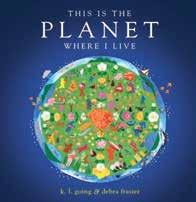
Seven-to-12-year-olds who want to pitch in this Earth Day will want to know what’s inside “Can I Recycle This?” by Jennie Romer, illustrated by Christie Young (Viking, $18.99).
This book shows how recycling works, why we should recycle, and the “rules”for being a good recycler. It also explains why some things can’t be recycled and how a kid can make even more of a difference for the planet.
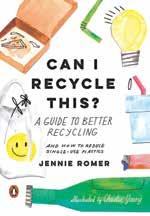
You can’t leave your teen reader out of this day: “Global” by Eoin Colfer and Andrew Donkin, illustrated by Giovanni Rigano (Sourcebooks for Young Readers, $14.99) is a graphic novel about a boy and his grandfather who are trying to make a living by fishing in a depleted area of the ocean; and a boy in the northern part of Canada who sees fewer polar bears on the melting ice. This book’s audience –13-to-17-year-olds – already know why these dual stories are told but just in case, a nice chapter on global warming rounds out the tale.

For adults, wanting to preserve the planet may start with knowing what’s on it.
Slime is not just for kids. That’s the surprise in “Slime: A Natural History” by Susanne Wedlich (Melville House, $28.99); in fact, slime is necessary for life on Earth.
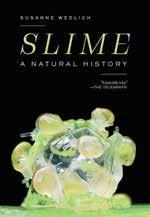
In this book, you’ll learn why we need things that are slimy, what chemicals make slime, and why you shouldn’t be disgusted by it. This is a fun science book, and it won’t make you say, “Eeeeuwww.”
And finally, “Lapidarium: The Secret Lives of Stones” by Hettie Judah (Penguin Books, $30.00) is not just for rock hounds or jewelry-wearers. This book on rocks and minerals is a lively story told with history, science, pop culture, and more than a few jaw-droppers; you’ll learn about stones you’re familiar with and rocks you’ve never even heard about. Seriously, this is a fascinating book. Don’t miss this little gem.

If these Earth Day books aren’t enough for you or your family, be sure to check in with your favorite librarian or bookseller. They’ll have books on global warming, ecology, Earth Day, and natural life on this planet, gardening, wildlife, and other Earth Sciences. Best of all, they’ll know exactly what you want to read, or give your kids to read. Just bring your own bag.



“Nobody wants to live in a community that has littering and garbage,” says Major Zachary O’Lare, a member of the Prince George’s County Police Department working for the Deputy Chief of Investigations and Forensics. Major O’Lare has been with the Prince George’s County Police Department for almost 20 years, and recently joined the Environmental Task Force. He’s part of an interdepartmental team cracking down on litter and illegal dumping.
Illegal dumping isn’t just an eyesore—it has real health consequences for Prince Georgians. Those old mattresses, couches, and tires on the side of the road are fire and safety hazards that also contaminate our drinking water and create breeding grounds for disease-carrying rodents and insects. All these effects result in environmental and public health issues, falling property values, and spending taxpayer dollars from the County budget to clean up the dumping sites.
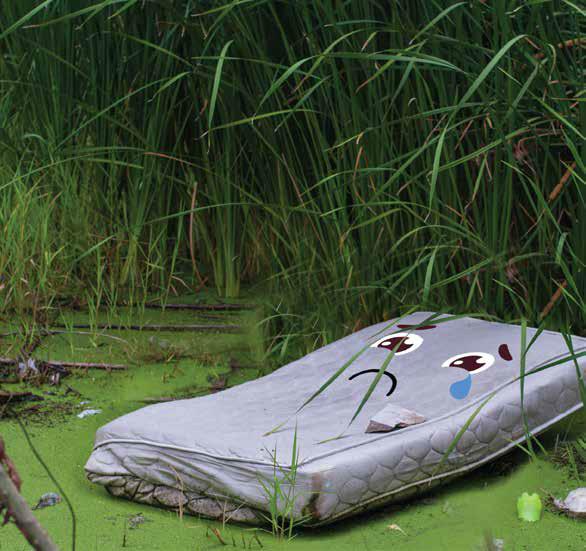
That’s why Major O’Lare and the task force are holding people accountable. Prince George’s County is placing hidden cameras at dumping sites to record people illegally dumping, and then tracking them down. It’s not just about aesthetics—illegal dumpers need
to answer for their impact on public health and safety.
The task force needs help from Prince Georgians though. Residents should report illegal dumping sites they see throughout the County so problem areas can be identified and cameras can be placed nearby.
The task force is already seeing results. In one Upper Marlboro case, an offender received $17,916 in fines and restitution, a 1 year suspended jail sentence, 3 years’ probation, and 100 hours of community service for dumping tires. This strong response sends a message: Prince George’s County is taking the health and safety of its residents and environment seriously, and jeopardizing that will not be tolerated.
There are solutions for your mattresses, couches, old tires, and more. The County’s improved curbside bulky trash collection program has made it easier to get rid of bulky trash for residents receiving County-provided services – just leave up to two (2) bulky items next to your trash on regular collection days each week to have them picked up, no appointment needed. For scrap tires and white goods, such as refrigerators, washer, dryers, and other appliances, appointments are still need through PGC311. WI
Keeping Prince George’s County beautiful is a job for all of us who live, work, and play here. Find out how you can help by properly disposing of all your waste.
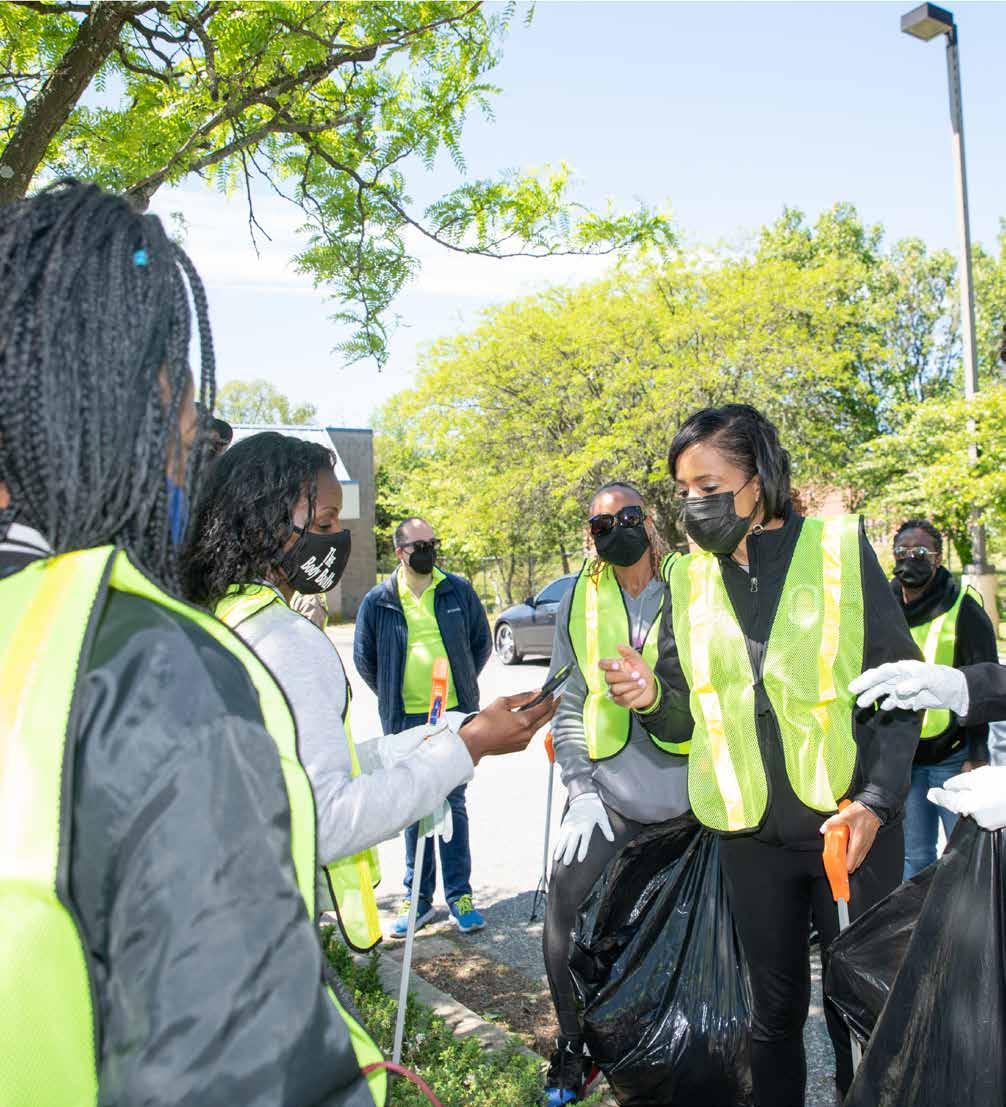 Angela D. Alsobrooks, County Executive
Angela D. Alsobrooks, County Executive

Vice President at National Association of Black Scuba Divers

On her work restoring coral reefs: “I want people to have access to the beauty of our oceans and what it offers us. It’s an amazing space. So, conservationist or citizen scientist—call me whatever you want, but I really just want to make sure that our next generations have an earth to live on. It’s pretty much that simple.”

Organizing Director for the Center for Oil & Gas Organizing
On climate justice: “I want people to know that there’s a lot of science and a lot of numbers, but at the end of the day, we’re working for the good life. That’s it. People want to have healthy lives. People want to be able to protect the land that they live on and maybe even get buried next to their elders and their grandparents. And we can’t do that if we’re not taking care of our planet. I think people want to create this narrative that climate change is too technical for the common man to understand—and that’s not true.”
Founder of Byrd’s Nest Box, a fresh produce company specializing in curated farm boxes

On the big picture behind her company: “I was born and raised in D.C., but during the summertimes, I traveled to North Carolina a lot to visit my grandparents and be on their farm. So I’ve merged my family history and genealogy, and African American homesteading traditions, with my business. That’s really the principle pillar: to honor the traditions of African American homesteaders and farmers and growers.”

Justice Staff Attorney at the Chesapeake Bay Foundation
On supporting community voices: “A lot of the work that we’ve done can be traced back to just people paying attention and refusing to be shut out of spaces—people supporting other community members, people not ignoring each other. Not everything has to be legal intervention. Sometimes support, advocacy and paying attention is just as important as being able to actually file a comment letter.”
Executive Director of The Green Scheme
On the Ward 8 Water Watchers youth program and Oxon Run Creek: “We bring subject matter experts to our community so our community can become change agents for the environment, for their health. We do it using our natural resources, our backyard, our green space, our creek space. And we just make it an educational experience.”

Director of the short film “Trashman”

On his recent film about trash pollution in his Ward 8 neighborhood: “As a filmmaker, and an environmentalist, I think it’s important to really show how bad the issue is in an artistic and visually appealing way that doesn’t turn people off, but also pulls them in and makes them interested and really care—and care enough to want to do something about it.”

Junior majoring in Interdisciplinary Environmental Studies at Howard
On choosing Howard to study environmental issues: “I feel like it was important to be surrounded by my peers who look like me to have these conversations, knowing that a lot of people of color are experiencing environmental racism on a different level.”
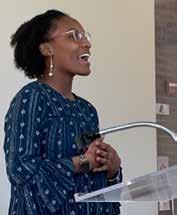
Staff Scientist for the Healthy Communities program at Earthjustice, an environmental litigation organization
On the work she does as a scientist and science communicator: “A lot of my job is looking at the science behind ‘Well, what exactly are these chemicals? How do they cause human health harm?’... A lot of it is taking fairly complex scientific explanations and then translating it not only for my team, but also for our partners and clients so that they can do the work out there, doing advocacy at the local level.”


Students from Bard High School Early College in Southeast contributed their views on Earth Day and why it is important to protect the earth.
1. GERNISE JOHNSON
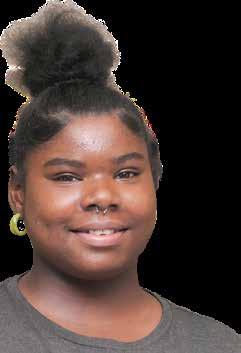


BARD HIGH SCHOOL EARLY COLLEGE
Protecting our Earth is important because the Earth can only continue if we protect its biodiversity. Our Earth provides us with food and water to sustain life. To survive, we depend on our planet Earth to live. We must protect the Earth, the place in which we live. Earth is where life is possible. To protect our Earth, we should reduce, reuse and recycle. We should cut down on what we throw away. We should volunteer for clean-ups in our community. Small steps could lead to BIG progress!
2. RON’MAY JACKSON

BARD HIGH SCHOOL EARLY COLLEGE
The Earth is a wonderous place! It gives the plants life. It allows us to live on it so that we can prosper, grow, and do new things. What do we give it in return … pollution, toxic gasses, and man-made forest fires. The Earth makes us cold. The Earth keeps us warm in the summer. Just because we are dissatisfied with what goes on with our Earth does not mean we should treat her any way we want. Love the Earth. Cherish the Earth. Happy Earth Day!
3. KAIDYN AULL
BARD HIGH SCHOOL EARLY COLLEGE
I have mixed emotions about the Earth. I don’t like how my people treat it because it stems from us. Trash is everywhere, in the parks, rivers, and so much more. I feel like, as a community, we can do a lot better with how we treat the Earth, because things are getting worse day by day. We can do different things like have community service-based cleaning of neighborhoods and river banks, as well as recycling items in the home. The Earth is our home. We want it to be here for us. WI

The founding of Earth Day in which the environmental movement highlights the need for worldwide conversation and ecological education came about with the publishing of a bestselling book in the 1960s and the vision of a U.S. senator.
In the decades leading up to the first Earth Day, Americans were consuming a great deal of leaded gas through energy-wasting automobiles, and companies put smoke and sludge out into the air and water without any fear of retaliation from government officials, according to Earthday.org. Air pollution was commonplace and accepted as a byproduct of economic progress.


However, the approach to addressing environmental issues increased its urgency significantly with the publication of Rachel Carson’s bestselling New York Times book, “Silent Spring” in 1962. The book documented the harm caused by the indiscriminate use of pesticides detrimental to humans in the ecosystem. Carson accused the chemical industry of spreading mistruths and elected officials of accepting the industry’s marketing claims without inquiry. The book was met with fierce opposition by chemical companies, but it managed to sell 500,000 copies in 24 countries. The book has been credited for raising public awareness and concern for living organisms, the environment and the close ties between pollution and public health. Earthday.org reported in 2006 that “Silent Spring” was named one of the 25 greatest science books of all time by the editors of “Discover” magazine.
With the popularity of “Silent Spring,” progressive U.S. Sen. Gaylord Nelson, (D-Wis.), expressed his concern for national environmental degradation. Nelson had distinguished himself in the Senate as a champion of civil rights, women’s rights and President Lyndon B. Johnson’s programs to fight poverty. However, when a massive oil spill occurred in Santa Barbara, California in 1969, Nelson decided to take his activism to another level. Observing the growing potency of the anti-Vietnam War movement—Nelson opposed the U.S.’s role in the conflict—he wanted to drum up the same energy and pas-
sion for cleaning up the nation’s water and air.

Nelson, along with U.S. Rep. Peter McCloskey, R-Calif., recruited a young activist, Denis Hayes, to organize teach-ins on college campuses on April 22, a weekday between Spring Break and final examination periods. Hayes managed to build a national staff to promote the teachins. Soon, other organizations and faith groups joined in. The decision was made to rename the event Earth Day, which immediately caught people’s attention, Earthday.org reported. The first recognized Earth Day in 1970 had 20 million Americans advocating for a safe environment.
Earth Day 1970 fueled the political activism of environmentally conscious Americans. By the end of that year, President Richard Nixon and Congressional legislators from both parties had created the EPA and passed the National Environmental Education Act, the Occupational Safety and Health Act and the Clean Air Act. In the following years, the Clean Water Act and the Endangered Species Act passed Congress and the Federal Insecticide, Fungicide and Rodenticide Act underwent a major revision.
Nelson lost re-election in 1980 and became counselor of The Wilderness Society afterward. President Bill Clinton awarded Nelson the Presidential Medal of Freedom, the nation’s highest civilian honor, in 1995 due to his environmental work and founding Earth Day.
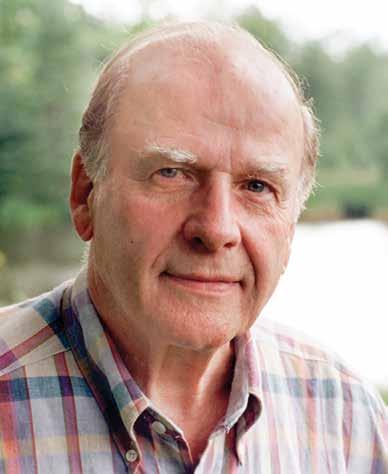
In years leading up to the 1990s, Hayes worked with a group of environmental leaders to make Earth Day a global event. In 1992, Earth Day activism spurred the United Nations Earth Summit in Rio de Janeiro. Earth Day 2000 saw Hayes organize a worldwide focus on global warming and a push for clean energy. Highlights of Earth Day 2000 had international and local activists using the Internet to organize activities around the world, while featuring a drum chain that traveled from village to village in Gabon on the African continent.
Today, Earth Day is recognized in 193 countries with more than one billion people participating in activities for a cleaner planet and combating climate change.
WI
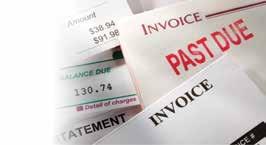
@JamesWrightJr10

With the popularity of “Silent Spring,” progressive U.S. Sen. Gaylord Nelson, (D-Wis.), expressed his concern for national environmental degradation.
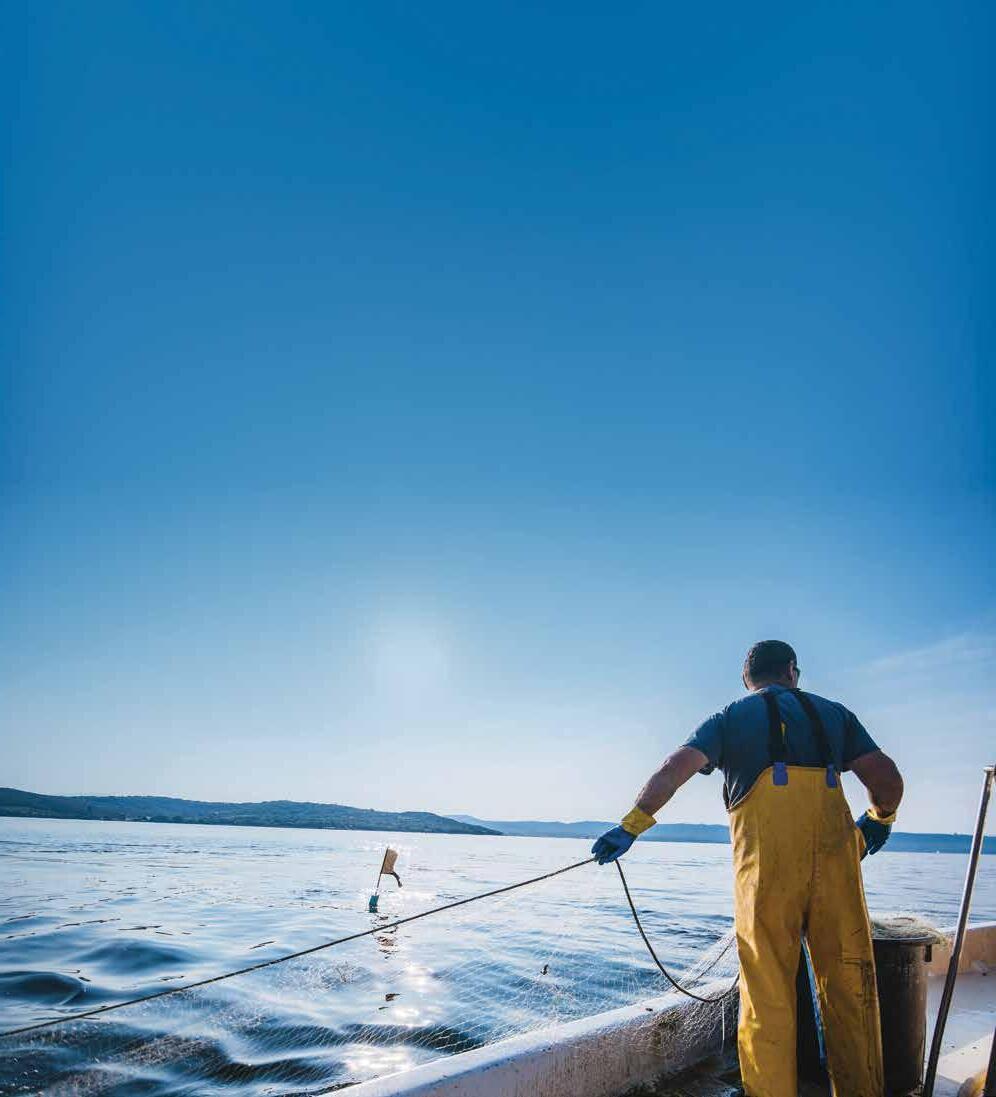

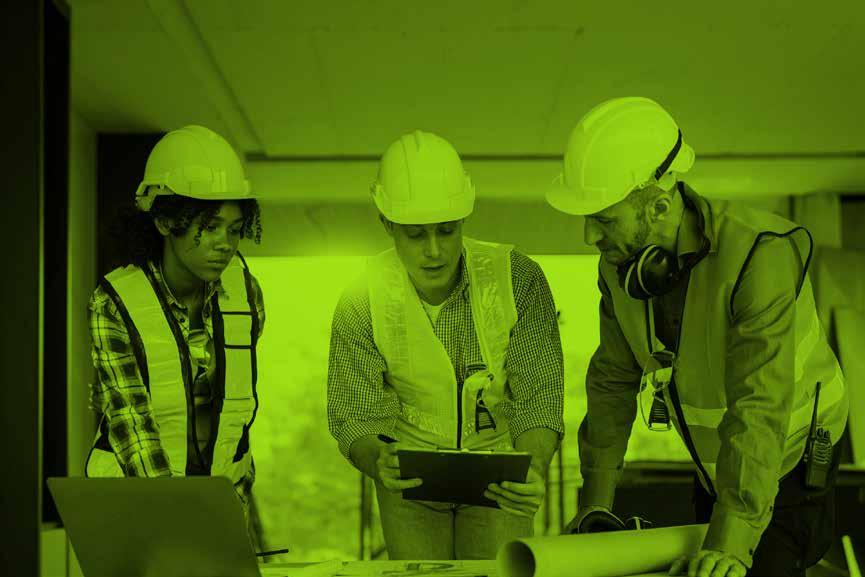
for Our unprecedented opportunity health equity, jobs and justice.JOIN US AT EDF.ORG